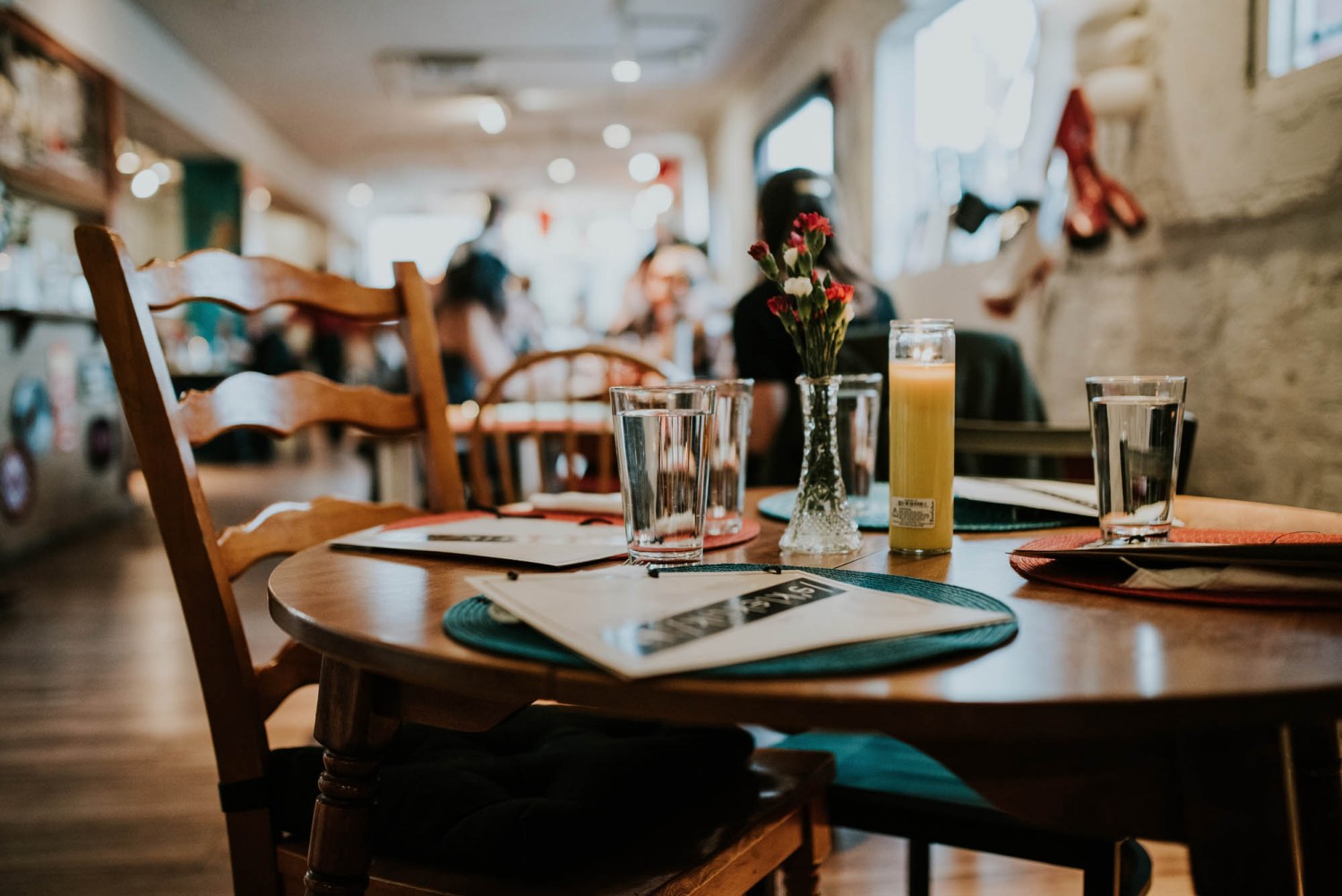
Backlash among medical community over Ford’s decision to open Peel restaurants
Premier Doug Ford was chuckling as he walked up to the podium just after 1:30 p.m. Friday to conduct a press briefing. His face was creased as he laughed, but business owners in Peel weren’t sharing the joke – neither were doctors and healthcare experts across the GTA.
With the novel coronavirus spreading at alarming rates across Brampton, news trickled out of Queen’s Park Friday morning that Dr. Lawrence Loh, Peel’s top public health official, had written to the Province requesting the region remain in a modified Stage 2 as Brampton COVID cases, test positivity and new infections soar.
Premier Doug Ford during Friday's press conference.
It was a last minute request from Loh who, as recently as Thursday, had shown no signs of pushing back against the Province’s new tiered, colour-coded pandemic-response system. In the hours leading up to the press conference it was unclear if the Premier would back the request. Until Ford spoke, Peel was heading for the orange (restrict) category, with indoor dining and gyms reopening in the region capped at 50 people.
Loh’s request was not fully embraced by the Ford administration, which instead moved the region into a more relaxed version of Ontario’s red (control) category. Unlike modified Stage 2, the rules mean Peel restaurants and gyms will be allowed to open with drastically restricted capacities: 10 people for indoor dining and 10 people for indoor exercise.
It’s a move Ford called a “happy compromise”. The compromise the Premier referenced is between an economic desire to see businesses reopen and the advice of Loh, the man trusted to make local public health decisions based on the medical evidence he is most familiar with.
Anthony Dale, president and CEO of the Ontario Hospital Association, criticized the “reckless” decision to ignore Loh’s advice in a statement, and called on the Province to reverse its plan “given the risks it poses to area hospitals, particularly William Osler Health System” (which runs Brampton Civic and Peel Memorial, as well as Etobicoke General Hospital).
Dr. Michael Warner, Medical Director of Critical Care at the Michael Garron Hospital, regularly shares his reaction to COVID-19 policy on Twitter. “We need to understand who’s making these decisions because a local medical officer of health actually requested that his region stayed in Stage 2,” he said in a video posted on social media Friday. “If he isn’t being listened to, then who is Doug Ford actually listening to?”
“The Province has announced this new framework and they’re looking to apply it and so we’ll continue to work with our Provincial partners,” Loh told The Pointer. His response stopped short of praising Queen’s Park, as he has in the past, but accepted the decision. He added that he “did notice that there is a loosening of restrictions,” but was working with local leaders to add “counterbalancing” measures to restrict spread among private gatherings. He repeated his messaging from the past week that these measures would mean there won’t be “unrestricted reopening in Peel” while the COVID situation remains so concerning, particularly in Brampton.
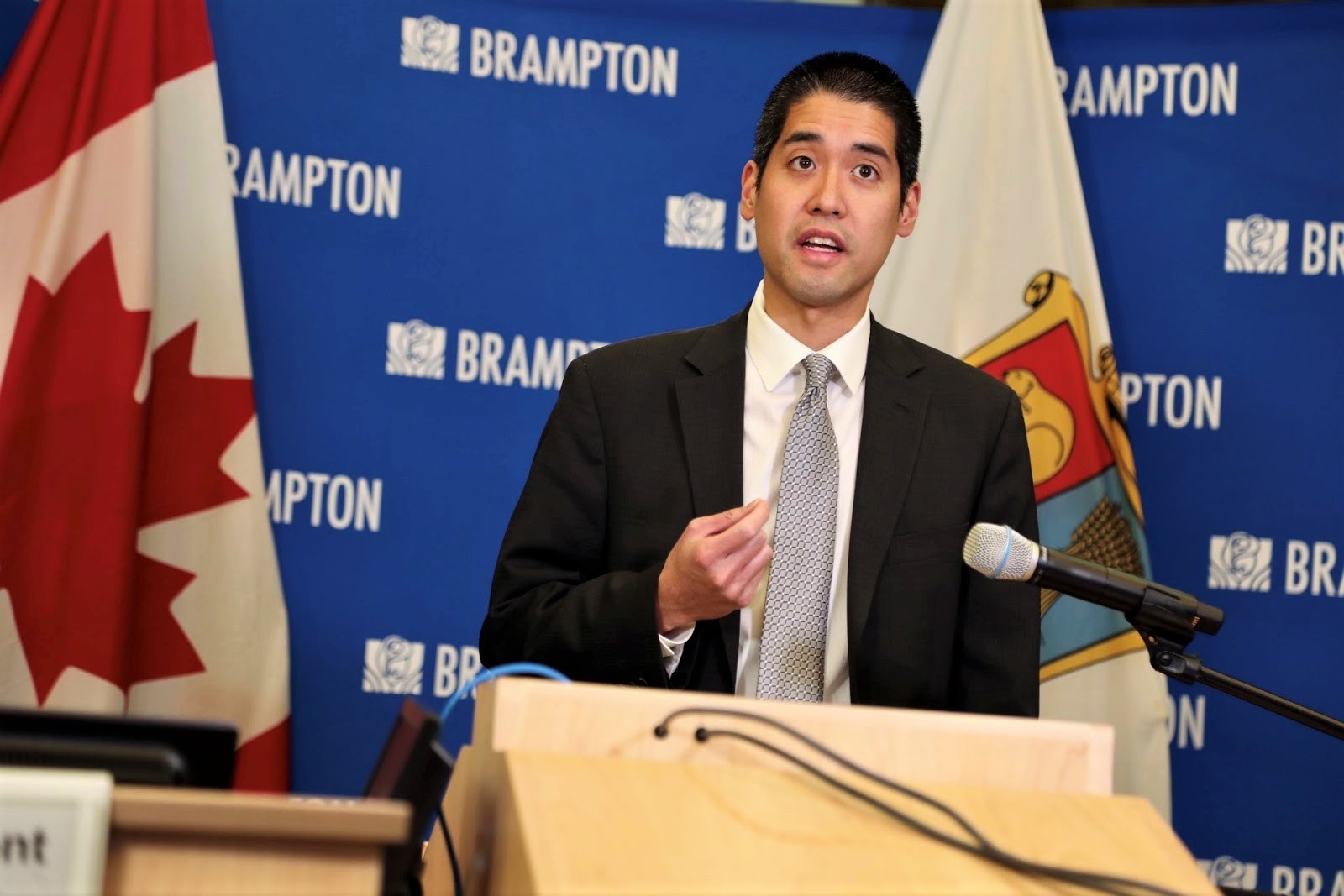
Dr. Lawrence Loh, Peel's chief medical officer of health
Ford wasn’t the only politician criticized by healthcare professionals. Brampton Mayor Patrick Brown, justifying the decision to reopen indoor dining, which he has lobbied for, repeated his false claim that no restaurant transmission has occurred in Peel.
Both he and Mississauga Mayor Bonnie Crombie, like so many elected officials, have been forced to balance economic concerns with public safety.
Santa Maria Restaurant and Bar, a family business whose proprietors trace their roots to Guyana, opened in Brampton five years ago and now depends on its patio and takeout business to survive. Surita Goberdhan said the kitchen is down to one chef. The family was forced to lay off staff and now works long hours to keep from shutting down.
“It’s been a struggle, and with the inconsistency of not knowing what tomorrow's news is going to be, it's been hard to plan.”
The restaurant, which serves Chinese and Caribbean cuisine native to Guyana, is a favourite among customers who enjoy the music and family-oriented space, she said.
“We've been paying our full rents as well and barely surviving, trying to keep our doors open to our community.” Goberdhan’s family was preparing to have tables of four as per seating limits under the orange (restrict) guideline, but Friday’s unexpected announcement to move Peel into a modified version of the red restriction was the latest setback.
“It's very disappointing, because now we don't know when we're ever going to move over to that stage,” she said.
Peel’s mayors may be frustrated at the Province’s decision to limit reopening, with business owners begging for help, but neither voiced criticism. Both Brown and Crombie referenced the slight loosening of restrictions as a ray of hope for their local businesses. The emphasis on reopening, instead of the extended closures Loh asked for at the eleventh-hour, raises questions around whether the mayors were aligned with his request for the current shutdown to continue.
“To all our small business owners: I am truly sorry that you are not able to open to the degree you had anticipated,” Crombie said in a statement. “The reality, however, is that the picture in Peel has changed over the last several days, particularly in Brampton.”
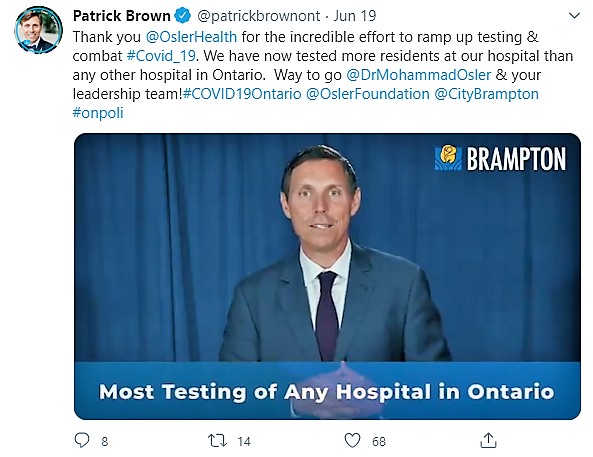
Brampton Mayor Patrick Brown previously used misleading screening figures, claiming tests done in Etobicoke were at "our hospital".
Brown appeared briefly on CP24 right after Ford’s announcement. He noted the modified red category would still allow Peel restaurants and gyms to open Saturday, although with far less capacity.
He went on to repeat his false claim, that viral transmission has not occurred in Peel restaurants. Crombie has distanced herself from the notion as provincial data show there has been a small amount of known spread in restaurants, while many infection points are unknown.
“My initial concern was that, when you look at our data in Peel Region, restaurants were not part of the spread,” Brown repeated. “They were not where COVID was being contracted. I do hope at some point we’re going to get help where we need it.”
Brown then launched into claims that can’t be confirmed, stating lunch and dinner meetings in restaurants have moved to private households where “the same observance of public health protocols” are not being followed. With so much business communication happening virtually it’s unclear why he thinks such lunches are shifting to people’s homes.
Data released last week by the Province show between August 1 and October 24, 3 percent of known outbreaks that occurred in Peel came from restaurants, bars, and clubs, while 4 percent were linked to gyms.
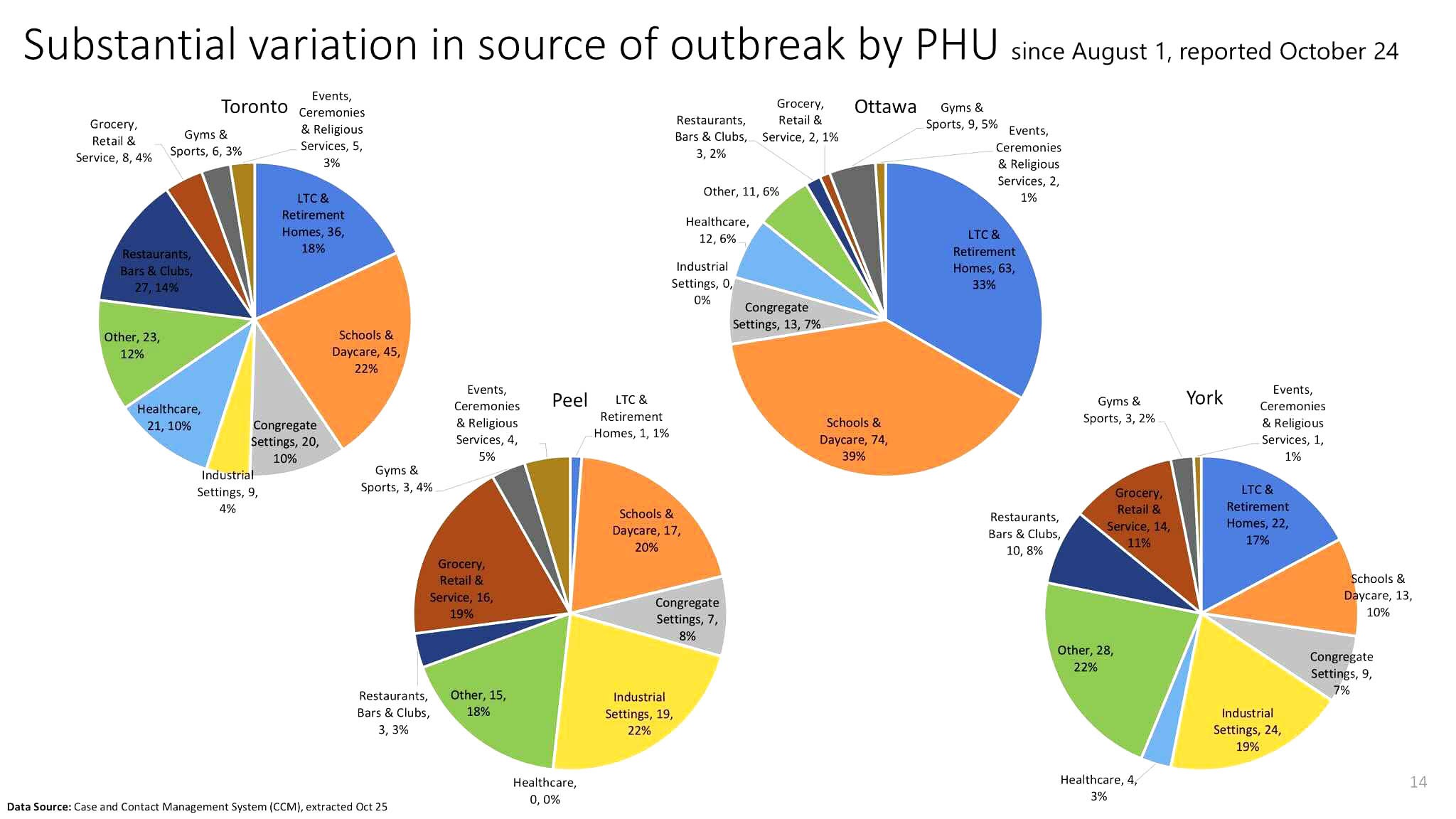
Data from the province contradicts Mayor Brown's claim that viral transmission has not been linked to restaurants in Peel.
Some 20 percent of transmission is attributed to community-spread and these infection sources are largely unknown. After previously being pressed by The Pointer, Loh also conceded restaurants could be a source of unknown community transmission.
When a chart was posted on Twitter to show Brown was offering misleading information during his interview, one doctor tweeted, “If he can’t interpret a pie chart, there really is no hope.”
Brown didn’t stop there. When pressed about Brampton’s alarming test positivity rate, he claimed it was because of changes to screening guidelines that require only those with COVID-19 symptoms be allowed to receive tests at official assessment centres.
This does not explain why Brampton’s test positivity now stands at about 11 percent, according to Health Minister Christine Elliott, more than double the rate of Mississauga and Toronto and more than four times the goal of being below 2.5 percent, she added. When test positivity rates go beyond 5 percent, epidemiologists have stated this signals the viral spread in the jurisdiction is not being controlled, and that testing and contact tracing is inadequate.
Brampton has been the focus of widespread criticism for the inability to manage the crisis and the potential risk this is causing not only for its residents but for the entire GTA region.
On September 4, Ford called the city “broken”.
Brown told The Pointer he was in regular contact with Queen’s Park, then repeated his talking points on restaurants.
“We didn’t need more restrictions on restaurants, they have been closed for the last 28 days when numbers spiked. The spike wasn’t related to restaurants,” he said in an email. “We know where the COVID transmission is coming from. We need resources and support for the most vulnerable in our community. Workers in industrial settings. Essential workers.”
He did not explain what this means but said supports include an “isolation centre” and more paid sick leave for essential workers. He also mentioned the need for more testing.
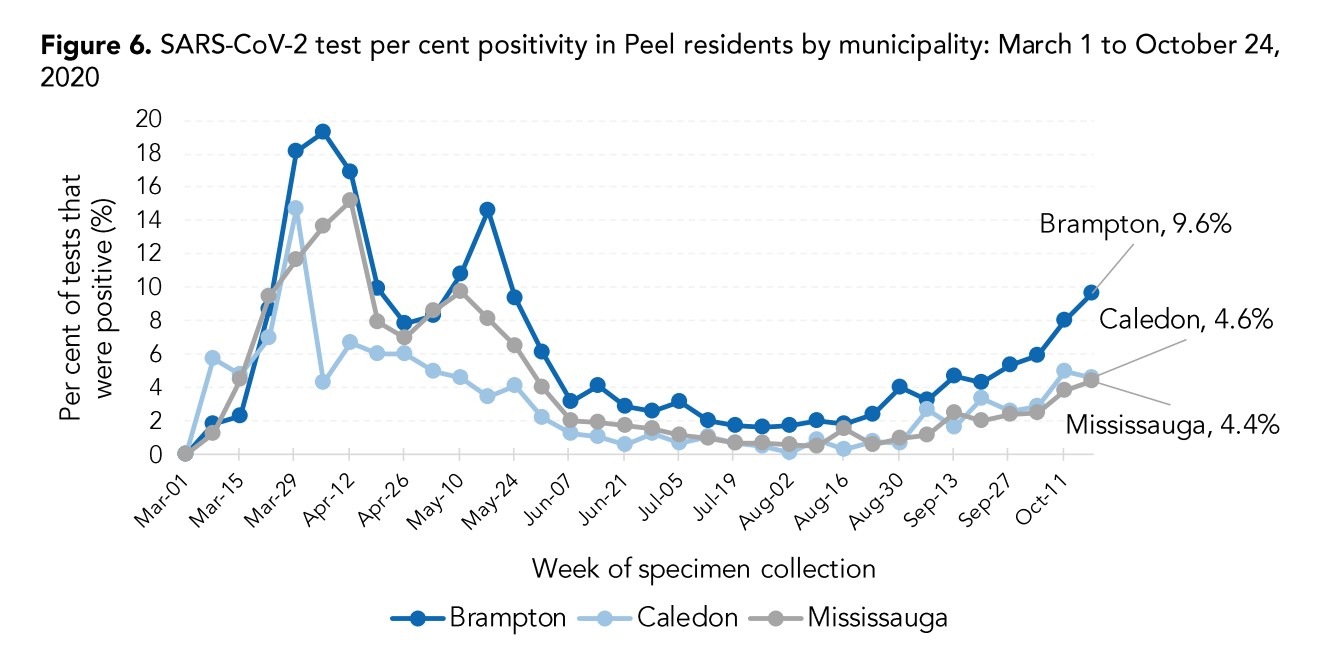
Data from the end of October show Brampton's test positivity rate sat at 9.6 percent. According to Minister Elliott that number has now risen to about 11 percent.
The city has been unable to meet its per capita targets under the Province’s goal of 50,000 tests daily in Ontario. Brampton has only met about a third of its share of this goal. But Brown has been largely silent on the issue and the fact Brampton has only had one assessment centre since the start of the pandemic. Mississauga has three, Toronto has 17 and Ottawa has seven.
The Pointer has repeatedly asked the Province why Brampton, Ontario’s worst hotspot, only has one permanent screening site, but no explanation has been provided.
Mounting criticism of Brampton’s handling of the COVID-19 pandemic reached City Hall in Mississauga. Last week, councillors voiced their frustration with Brown.
“That is probably one of the biggest calls I get from residents: how come we’re lumped in with Brampton? Maybe we should send a letter to the Premier and say ‘you didn’t let us separate from the region, but can you let us separate from Brampton when it comes to COVID?’” Ward 8 Councillor Matt Mahoney suggested during an October 28 council meeting. His Ward 2 counterpart, Karen Ras, took a more personal shot: “Mayor Brown needs to get a better handle on it other than staging the odd photo-op.”
The spread of COVID-19 in Brampton is also drawing the ire of Mississauga’s business community.
David Wojcik, president and CEO of the Mississauga Board of Trade, called on the Premier to separate restriction levels in each of Peel’s municipalities, pointing to the example of Windsor’s reopening in the Windsor-Essex region.
“It is beyond words why Mississauga continues to be held responsible for the conditions that exist in the Region,” Wojcik said in a statement.
In contrast to Brown, Crombie has clarified her message to acknowledge the risks of indoor dining. Unlike Loh, who is supposed to speak purely to the public health picture, Crombie has been clear she must look out for businesses too.
“My job as mayor is to try to balance public health priorities with economic realities,” Crombie told The Pointer in an email Thursday. She added: “I also believe that it is important for our community to understand the inherent risks of dining indoors as well as working out indoors… It is important that they know transmission can occur in these settings.”
Even with Crombie’s cautionary warning, the public health and political messaging is beginning to move in different directions. In Peel, the economy is a major concern for elected officials, while a potentially devastating second wave and the flooding of local hospitals is what Peel Public Health is trying to address.
“All of our metrics are going in the wrong direction,” Dr. Loh said at a Wednesday press conference in Brampton. The same day, he admitted to Mississauga councillors he was concerned about the region’s test positivity rate and said it indicated a problem with Peel’s testing regime.
“Either we’re not testing [enough] or we’re seeing … a true rise in cases, or both,” he said, with Peel’s test positivity rate the highest in Ontario. “And until we actually finally get a little more data, especially with our testing levels continuing to be brought up, we’re going to have to just assume that it’s both. We’re not testing enough and we’re seeing a genuine rise in cases.”
The message was a departure from Loh’s previous comments, where he has avoided the opportunity to ask the Province to add a second testing centre in Brampton.
Until Friday, he had cautiously embraced Queen’s Park’s previous decision to move Peel into the orange (restrict) category and begin reopenings with up to 50 patrons in restaurants (now they will be restricted to 10). Loh tabled several measures, including a ban on all indoor gatherings in private households, in an attempt to mitigate the impact of larger restaurant capacity, but told The Pointer Wednesday the decision was out of his hands.
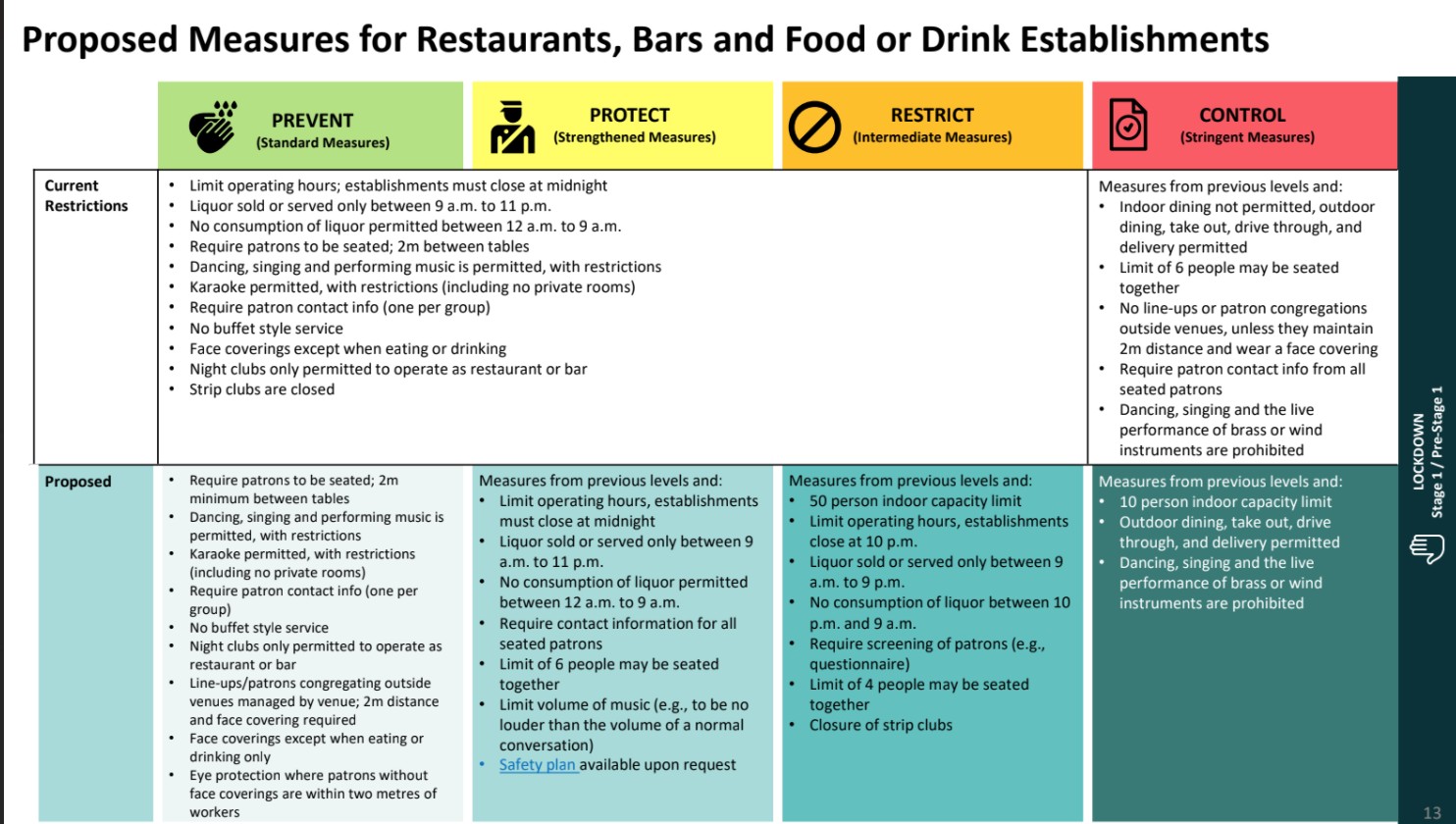
Peel Region will now move into a modified Red "control" category.
By Friday morning, the reality of reopening loomed large and Loh wrote to the Province. It was a delay that left everyone scrambling, but Peel’s top doctor says it was triggered by new information. “The situation has changed materially at William Osler Health Service in the last 24 to 48 hours,” Loh said.
The Province was aware of the concerning situation outlined to Loh, with Minister Elliott telling reporters Friday that “our hospital system is becoming overwhelmed” in Peel Region.
Dr. Naveed Mohammad, President and CEO of William Osler, told The Pointer the hospital network’s two full facilities (Brampton Civic and Etobicoke General) have reached a point where they are “severely limited” in their ability to accept new patients. Transferring patients to other hospitals, a measure mapped out in March to deal with hospital gridlock, over the past “14 to 16 hours” has helped to alleviate the stress a little, but a continued rise in COVID-19 patients could bury Osler and its neighbouring hospitals soon after.
The need to isolate all COVID-19 positive patients in their own room has swallowed up resources, Mohammad explained.
“In-patient capacity … is worse than the first wave,” he said. “We had [a] similar number of patients in the first wave, [they] didn’t require as much intensive care and they weren’t as sick as these patients are. We’re finding that the patients that are coming in right now happen to be much more severely ill than we noticed in the first wave. We haven’t pinpointed why that is happening.”
Mohammad’s warning, so stark it caused Loh to break ranks with Queen’s Park for the first time since the pandemic began, conjures images of New York or Italy during their first wave. In both global hotspots, hospital services were overwhelmed and mortality rates skyrocketed. It is the nightmare situation Ford has consistently said he wants to make sure Ontario avoids.
“You see what’s happening in the UK with lockdowns,” Ford said Friday, also drawing on examples in Ireland, Spain and France. “It’s running rampant and I just don’t want to get to that position that we have to lock down the province again.”
Despite his claims, Ford ignored the advice of medical experts and went forward with the reopening plan in Peel, under tighter limits than originally planned.
- Vjosa Isai contributed to this article
Email: [email protected]
Twitter: @isaaccallan
Tel: 647 561-4879
COVID-19 is impacting all Canadians. At a time when vital public information is needed by everyone, The Pointer has taken down our paywall on all stories relating to the pandemic and those of public interest to ensure every resident of Brampton and Mississauga has access to the facts. For those who are able, we encourage you to consider a subscription. This will help us report on important public interest issues the community needs to know about now more than ever. You can register for a 30-day free trial HERE. Thereafter, The Pointer will charge $10 a month and you can cancel any time right on the website. Thank you.
Submit a correction about this story


